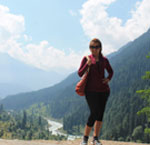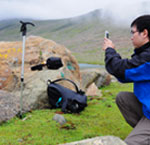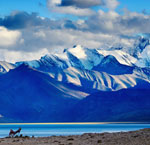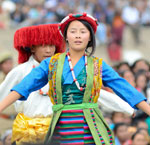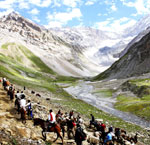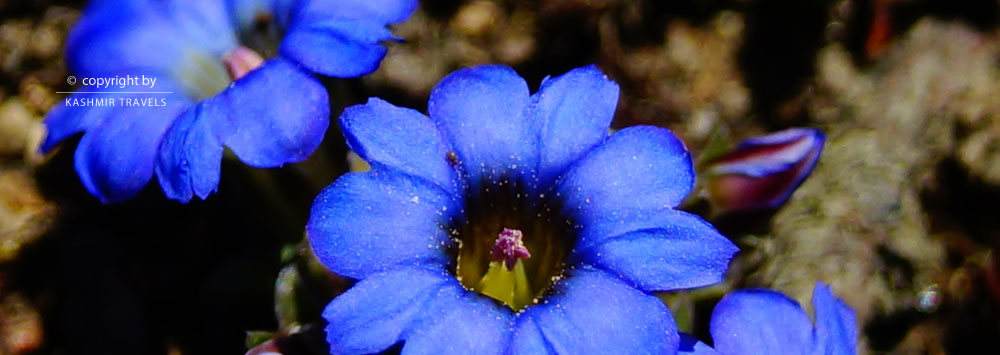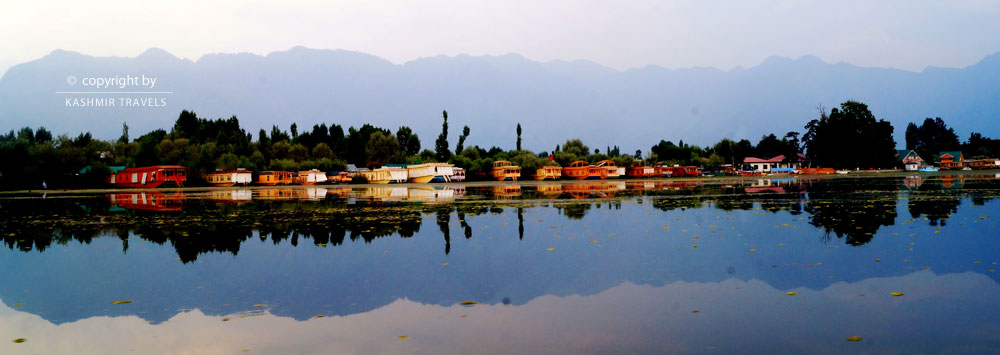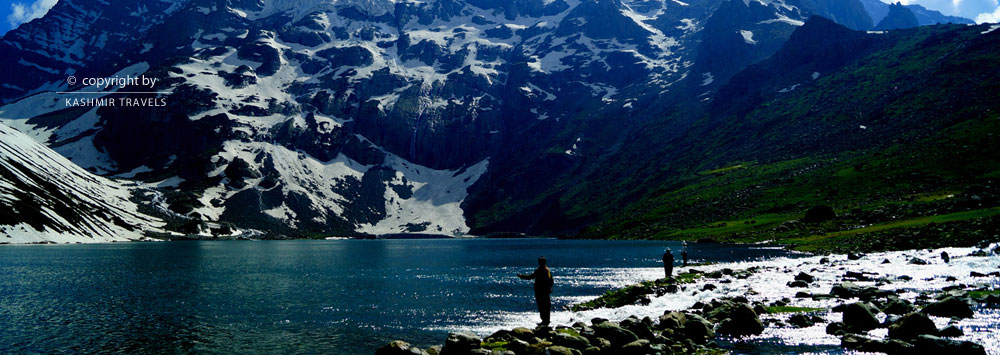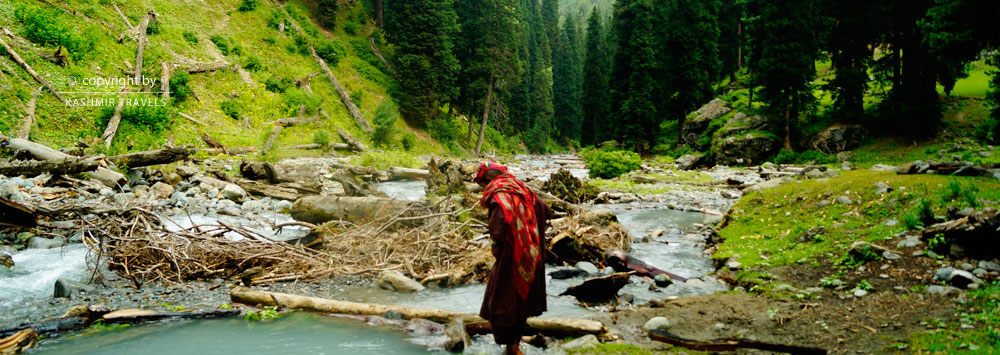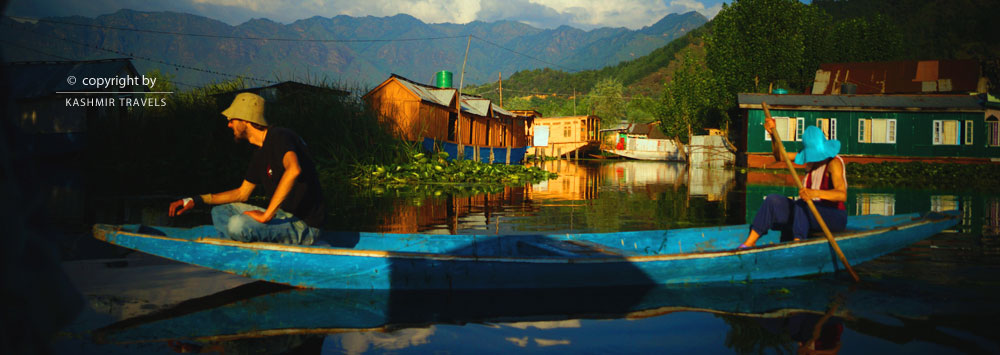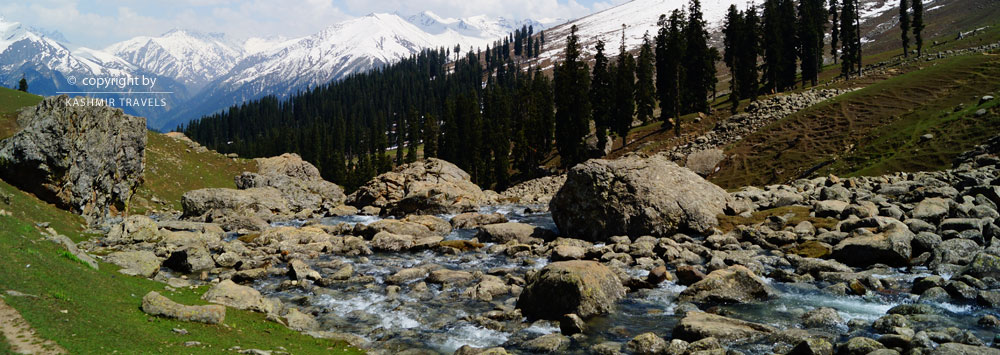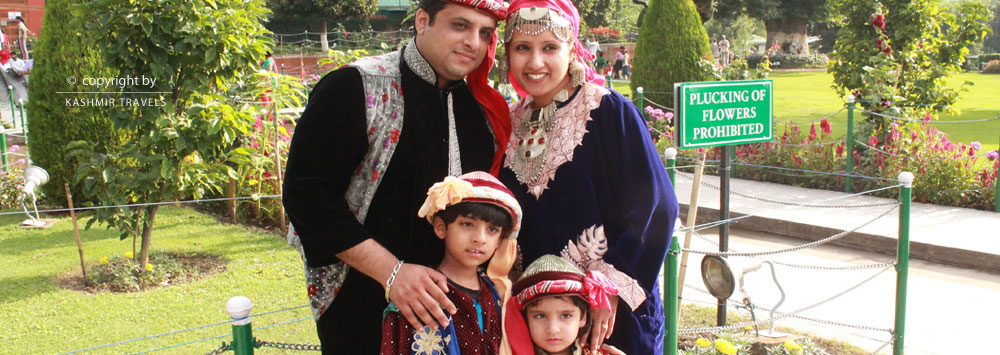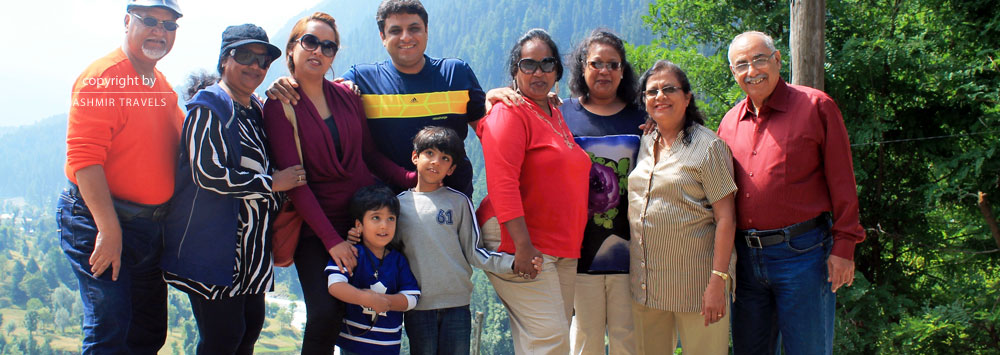Lakes and Rivers

“I believe that water is the closest thing to a god we have here on Earth."
- Alex Z. Moores
The water bodies apart from their charm have always proved instrumental in allowing societies to flourish. These beautiful waters, with their glassy, still surfaces and spectrum of colors, can showcase some of their most mesmerizing qualities. Jammu, Kashmir and Ladakh are surrounded by huge mountains, which remain covered with snow throughout the year. All the three regions of the valley are blessed with great lakes and rivers. Ladakh, being a cold desert, also abounds in water bodies.
There are many glaciers in the regions as well. The places thus, abound in water bodies and is known for its beautiful lakes and rivers. There are a number of lakes and rivers in each division. Some scintillating meres are located in the state at some stunning locations. These meres and other water bodies are a source of water to the agricultural land of the state. People enjoy river rafting, boat rides and other forms of adventure in these waters .
27 FAMOUS RIVERS OF JAMMU, KASHMIR AND LADAKH:
1.Indus River
Indus River, also called Sindhu or Mehran is a great trans-Himalayan river of South Asia
This river was regarded by the ancient Indians and the Persians as "the border river."
It is one of the longest rivers in the world, with a length of some 2,000 miles. The river rises in mountain springs northeast of Mount Kailash in Western Tibet, flows northwest through the disputed region of Kashmir.
2.Zanskar River:
The name Zanskar (Zangs-kar) means "white copper" or "brass.''The Zanskar River is the first major and north flowing tributary of the Indus River,which flows entirely within Ladakh, India. Zanskar River has two main branches, one in Doda with the main source near Pensi-La Pass and other branch is formed by Kargyo River (source near Shingo La) and Tsarap River (source near Baralacha La). It originates northeast of the Great Himalayan range and drains both the Himalayas and the Zanskar Range within the region of Zanskar.
The river offers a vast array of opportunities of expeditions for adventure seekers.During summers, one can enjoy river rafting in the stretches between Chilling to Nimmu.On the other hand, winters spice up the thrill by walking along the frozen river of Zanskar, which is often called as ‘Chadar Trek’ which has gained global recognition.
3.Suru River
The river is a 185 km long tributary of Indus River that flows largely through the Kargil district in Ladakh. The Penzella glacier near Pensi La is the main source of Suru River.
The river enters the Skardu District of Pakistani-administered Gilgit-Baltistan, coursing a brief length before joining the Indus at Nurla. It provides opportunities for rafting. The Suru Valley is the base camp for mountain expeditions to popular twin mountain massif Nun-Kun.
4.Nubra River
A tributary of the Shyok river, Nubra River is located in the Nubra Valley. The river system originates from the Siachen and Terong glaciers. In earlier Tibetan maps, it was referred to as Yarma Tsangpo.
5.Brengi River or Bringhi River:
The Bringhi or Brengi river located in Anantnag, Kashmir, flows for a total of 30km before feeding Jhelum River at Haji Danter, Anantnag. It is formed by the confluence of three streams: Nowbugh stream, Ahlan Gadol Stream, and Daksum Stream. It originates from the glaciers of Sinthan in Anantnag district. The river passes through a gorge at Daksum.
6.The Chip Chap River
The name literally means "quiet river."
It flows from the southern Xinjiang region of China to Jammu and Kashmir of India.
It originates at the eastern edge of the Depsang Plains and flows west, skirting around the Depsang Plains in the north. It discharges into the Shyok River and is one of the upstream tributaries of the Indus River.
7.Chenab River
The Chenab river means Moon River. It was called Asikni in the Rigveda . The name meant that it was seen to have dark-coloured waters. In the upper reaches, the river is also known as the Chandrabhaga. The Chenab flows in India and Pakistan and is born through the confluence of two streams, namely the Chandra and Bhaga. The river also plays a crucial role in the iconic Heer Ranjha and Sohni Mahiwal tales.
8.Dudhganga - It is a tributary of the Jhelum that flows from Ludurmarg and rises in the central Pir Panjal range near Tatakooti Peak. Two mountain streams, the Sangesafed and the Yachera, form this river. This river flows through Batmaloo Swamp near Srinagar.
10.Jhelum River
It is called Vyeth in Kashmiri, Vetesta in Sanskrit and Hydaspes in Greek. It originates at Verinag and flows through Jammu and Kashmir, to the Pakistani-administered territory of Azad Kashmir, and then into the Pakistani province of Punjab. It is the main waterway of the valley of Kashmir. The river rises from a beautiful spring called Verinag which is situated at the foot of a spur of the Pir Panjal mountain. The city of Srinagar is situated on the either side of the river Jhelum on the waters of which are beautiful moored houseboats which add to the scenic beauty of the city. According to the book Tareekh-e-Jhelum by Anjum Sultan Shahbaz, the word Jhelum is derived from the words Jal (pure water) and Ham (snow). He further records that some writers believe that Mughal prince, Dara-e-Azam reached a certain place on the river bank after winning many battles, where he fixed his flag and called it Ja-e-Alam which means 'Place of Flag' in Persian.
The passing time altered it to the name Jhelum. The Sanskrit name Vitasta of the river is derived from an apocryphal legend regarding the origin of the river as explained in the Nilamata Purana. It is said that Hindu goddess Parvati was requested by the sage Kasyapa to come to Kashmir to purify the land from evil practices and impurities of Pisachas living there.
The former then assumed the form of a river in the Nether World. Lord Shiva is believed to name her so after making a stroke with his spear near the abode of Nila (Verinag Spring). By that stroke of the spear, Goddess Parvati came out of the Nether World. Shiva himself named her as Vitasta. ( from Vitasti meaning a particular measure of length defined either as a long span between the extended thumb and little finger, or as the distance between the wrist and the tip of the fingers, and said to be about 9 inches; since he excavated a ditch measuring one Vitasti.The lakes originated by the river are Wular Lake, Dal Lake, Manasbal Lake,Gangabal Lake,Nigeen Lake,Anchar Lake, Khanpursar and
Gil Sar.
11.Lidder River:
Lidder is altered by the local Sanskrit name Lambodari meaning 'long bellied goddess'.
The river originates from Kolahoi Glacier in Sonamarg and gives rise to Lidder Valley. The water is crystal blue and is mainly used for irrigation and drinking purposes. The river houses various types of fish including Brown trout and Rainbow trout.
12.Markha River:
The Markha River is a river in Ladakh, India. It is a tributary of the Zanskar River. It originates from the Kolahoi Glacier and feeds the Jhelum River.It lies within the Hemis National Park.
Markha Valley is one of the most popular trekking routes.
13.The Neelum River, or Kishanganga
The river has traditionally been known as the Kishanganga River ; however after the partition of India in 1947, the river was renamed the Neelum River in Pakistan in 1956. It is named after sapphire, a precious stone.
It originates in the north of Jammu and Kashmir, Pakistan's Azad Kashmir and then merges with the Jhelum River. It is fed by a number of small streams arising on its way. The waters are abode to different kinds of fish. Some of the most commonly found fish are brown trout, rainbow trout, anyour and shuddgurn.
14.Poonch River
The Poonch River is also known as Punch River, Punch Tohi, Tohi of Punch.It is a tributary of the Jhelum River that flows through Jammu and Kashmir in India, and Azad Jammu and Kashmir in Pakistan. The Poonch River is unique in having warm water in its lower and middle reaches and cold water in its upper reaches.
15.Rambi Ara
It is a tributary to the River Jhelum located in Shopian District of Kashmir. It joins the Veshaw River near Sangam in Anantnag District before the confluence finally meets the Jhelum. The river springs from the Pir Panjal Range. It is known for fluctuating water levels. Rambi Ara has two tributaries and its streams irrigate thousands of hectares of agricultural land.
16.Sandran River
Sandran River originates near Sarbal Pass in the southeastern border areas of Kashmir Valley. It flows into the Jhelum River at Takia Bahram Shah, in Khanabal.
17.RAVI RIVER:
It was known as Irawati to ancient Indians. The river is a trans-boundary river crossing North-western India and Eastern Pakistan. It
The waters of Ravi are allocated to India under the Indus Water Treaty. It is an integral part of the Indus River Basin and forms the headwaters of the Indus basin.
18.Sindh River
Located in the Ganderbal district of Jammu and Kashmir, it is a major tributary of the Jhelum River and is 108 kilometres long. The Sind Nullah has its source in the Inner Himalayas at Dras. It is 96 km in length. The famous health resorts of Sonamarg and Ganderbal are situated on its banks. Its water is used for irrigation purposes and its water is used by 'Sind Valley Hydroelectric Power Project' to produce electric power.
19.Tawi River
Tawi flows through the city of Jammu and is a major left bank tributary of the river Chenab. Tawi river is considered sacred and holy, as is the case with most rivers in India. It springs from Kailash Kund Glacier at Soej hills in Bhaderwah. Chenani hydroelectric power project constructed on River Tawi has a capacity to generate 23 MW of power.
However, the flow of water in the river has been decreasing in recent years due to the retreating of its source glacier.
20.Ujh River
The Ujh river (or Ujjh river) is a tributary of the Ravi River that flows through the Kathua district in the Indian union territory of Jammu and Kashmir. Ujh River is the second most important river of the district Kathua. The water of Ujh River is utilized for drinking purposes. Apart from irrigation purposes it also helps in transportation of timber from hills to plains in bulk.
21.Veshaw River
The river is a major tributary to the River Jhelum located in Kulgam District in the Kashmir Valley. It originates in the Pir Panjal Range and forms a waterfall at Aharbal.
22.Yapola River
The river is also known as the Wanla River. It is located in Ladakh and flows into the Indus River near Lamayuru.
23.Neeru river
Neeru river or Neru river is tributary of the Chenab River. Kailash Kund is tge source of the river.The Gupt Ganga temple of Bhaderwah is located on the bank of this river.
24.Marusudar River
Marusudar river or Maru Sudar river is the largest tributary of the Chenab River.It springs beginning from the Nunkun glacier of the Warwan Valley .As of November 2021, the Pakal Dul Dam is under construction across the river. Also, 800 MW Bursar Hydroelectric power project is under construction on the river.
25.Shyok River
The Shyok River flows through Ladakh in India and the Northern Areas of Pakistan.It
rises in the Karakoram Range of Jammu and Kashmir and is a notable tributary of the Indus River which springs from the Rimo Glacier, one of the tongues of Siachen Glacier.The river widens at the confluence with the Nubra River. Tributaries of the river include Chang Chen Mo River, Galwan River, Nubra River and Saltoro River.
26.Tsarap River
The Tsarap River forms the eastern part of the Zanskar valley of Ladakh. The river originates from the glaciers near the Pankpo La Pass. Tsarap Chu plays a crucial role in the irrigation purposes of the Zanskar Valley. Moreover, it also offers opportunities for rafting and adventure.
27.DRAS RIVER:
The Dras River, also spelt Drass River, is located in the Kargil district of Ladakh . Its source lies in the Machoi Glacier near Zojila Pass and is an important tributary of the Shigar (South) River. The river is set against the snow-laden summits . There are several campsites near the river where one can soak in the natural beauty and gorgeous views of the snow-capped mountains.
Apart from these rivers, many meres adorn the already beautiful land. The lakes in all regions are extremely beautiful, clear and scintillating. Circumscribed by the Himalayan mountains on all sides, these natural treasures adorn the lands of all three regions.
FOLLOWING ARE 28 FAMOUS LAKES OF KASHMIR, JAMMU AND LADAKH
1. Dal Lake
It is known as the “The Jewel of Srinagar'',"Lake of Flowers" or "Srinagar's Jewel". Dal Lake spreads across an area of around 26 square kilometers and is the second largest lake in Jammu and Kashmir, including being the visited place in Srinagar by tourists and locals. It comprises four basins; Gagribal, Lokut Dal, Bod Dal and Nigeen (although Nigeen is also considered as an independent lake). Lokut Dal and Bod Dal each have an island in the centre, known as Rupa Lank (or Char Chinari) and Sona Lank respectively. Housing a vast array of spellbinding Shikaras, traditional wooden houseboats, and floating markets selling various items including saffron and handicrafts, it bewitches one and all. It won't be an exaggeration to say that a trip to Kashmir without getting to experience a houseboat-stay is sheer blunder since nothing compares to the feeling of drifting-off into the sunset on a houseboat. There are over 1000 houseboats in Dal and Nagin lakes.During the winter season, the visitors also enjoy ice skating on the frozen lake.Through the shikara on its waterways, one can visit famous Mughal gardens of Kashmir and other places .
2. Nigeen Lake
An offshoot of Dal Lake, Nigeen Lake is an offshoot of Dal Lake . The name is derived from the word "nageena", which means "the jewel in the ring". It is also connected to the Khushal Sar and Gil Sar lakes via a channel known as Nallah Amir Khan. The lake is surrounded by a large number of willow and poplar trees.
3. Wular Lake
Located in Bandipora district in Kashmir, it's one of the largest freshwater lakes of Asia, encompassing an area of more than 130 sq km. The lake supports rich biodiversity and provides flood protection to the entire Kashmir Valley. Moreover, it offers opportunities of boating, water ski, and other water sports. The high leaping waves are Ullola in Sanskrit, meaning "stormy leaping, high rising waves". The lake was also called Ullola in the past which means 'high leaping waves' in Sanskrit. It is believed that the origin may also be attributed to a Kashmiri word 'Wul', which means a gap or a fissure. The lake abounds in fish which make up a significant part of the diet for thousands of people living on its shores and living in other areas of Kashmir Valley. The lake also sustains a rich population of birds including the black-eared kite, Eurasian sparrowhawk, Himalayan golden eagle, koklass pheasant, rock dove,alpine swift, barn swallow, golden oriole and others.
4. Mansar & Surinsar Lake
Surinsar and Mansar Lakes are considered as twin lakes, situated 9 km from each other.Surinsar-Mansar Lakes were designated as Ramsar Convention in November 2005. The lakes are high in micronutrients which make it an attractive habitat, breeding and nursery ground for migratory birds .The Surinsar Mansar Wildlife Sanctuary is located in the midst of both lakes. Mansar Lake is located 62 km from the city of Jammu.
Mansar is primarily fed by surface run-off and partially by mineralised water through paddy fields.It is also a holy site, sharing the legend and sanctity of Lake Manasarovar. During the Baisakhi festival, it becomes the most visited place for tourists. It also offers boating facilities. Newly married couples come to Mansar Lake and do three ‘Parikarmas’ of this water body to seek blessing of the lord Serpents.
The lake abounds in various types of fish.
Surrounded by beautiful hills and dense forests, Surinsar Lake is situated 42 km from Jammu city by road.It is rich in flora and fauna and avifauna. According to Hindu mythology, the origin of this lake is associated with the warrior of Mahabharata, Arjun. A small island lies in the middle of the lake which is home to thousands of bats. Though swimming and boating were discouraged due to religious beliefs,there has been a change now allowing facilities of boating.
5. Gadsar Lake
The name Gadsar means the lake of fishes in Kashmiri .It is one of the highest lakes in Kashmir and can only be reached through the alpine trek. It is situated in the “valley of flowers” .It is situated in Ganderbal district of Kashmir valley at an elevation of 3600 meters. The waters get frozen in the winter season. The lake is fed by melting glaciers . Brown trout fishing is popular here.
6. Manasbal Lake
The lake has earned the sobriquet of "supreme gem of all Kashmir Lakes."Manasbal Lake is a freshwater lake located in Ganderbal District of Kashmir. The name Manasbal is said to be a derivative of Manasarovar. It is situated at a distance of 28km from Srinagar and is one of the deepest lochs of Jammu and Kashmir. The lake is a paradise for bird lovers since it is home to many aquatic birds. Apart from this, one can also find a Mughal garden called Jaroka Bagh built by Nur Jahan by the lake. The beautiful waters abound in lotus and waterlily flowers. Two beautiful gardens are stationed on its banks that make a perfect camping ground . "
7.Gangabal Lake
The Gangabal Lake is also called Harmukh Ganga, since it is situated at the foot of Mount Harmukh at a height of 3570 m in Ganderbal district of Kashmir. It is home to a variety of fish including brown trout and rainbow It. It is believed to be the home of Lord Shiva therefore is sacred to Hindus. Each year Kashmiri Hindus take pilgrimage to the lake on the Ganga Ashtami. In the past , Kashmiri Hindus used to immerse the ashes of their dead ones in the waters of this lake.
8. Tso Moriri Lake
Tso Moriri or Lake Moriri or "Mountain Lake", is one of the highest lakes in the world, located in Ladakh region.One can enjoy night camping beside it and also soak in the marvelous beauty of the Rupshu Valley. There is also a monastery nearby .The lake attracts a range of unique fauna, including migratory birds and other animals.
9. Tsokar Lake
Located at an elevation of 5000 m near Rupshu in Leh, it is surrounded by hot water springs. . The lake contains a heavy amount of salt giving it a pristine white sheen.
10. Pangong Lake
The famous lake portrayed in the Bollywood movie “Three Idiots”, Pangong Lake is a beautiful lake located near Leh-Ladakh in the Himalayas. The waters of the lake are crystal clear and blue in color. A range of migratory birds can be seen here. The Pangong Lake is located and having crystal clear blue water. The water gets frozen in the winter season.
11.Anchar Lake:
Anchar Lake is located near Soura area in the city of Srinagar in Kashmir. It is connected with the famous Dal Lake via a channel "Amir Khan Nallah". Though close to becoming a dead Lake it is still considered ideal for bird watching. Tourists can also enjoy shikara rides here.
12.Brari Nambal:
Brari Nambal, is also known as Baba Demb. It is a small freshwater lake located in Srinagar, Kashmir. It is connected to the Dal lake via a channel and is therefore sometimes referred to as a lagoon of the Dal lake. It is currently in deteriorated condition however efforts to revive it are in progress. It was commissioned by Sultan Zain-ul-Abidin in the 14th century and according to folklore, the banks would house herbal and therapeutic baths.
13.Gil Sar
It is a freshwater lake located in Srinagar Kashmir, sometimes considered a part of the Khushal Sar lake but is separated from it by a narrow strait. Khushal Sar and Gil Sar used to be the primary sources of water for the inhabitants living around these water bodies but currently is not in the same condition.
14.Hokersar:
The Hokersar is a wetland conservation area in Zainakote near Srinagar, Kashmir. It is a designated bird sanctuary.
15.Kausar Nag or Kausarnag
Located in the Pir Panjal range in Kulgam district of Kashmir, at an elevation of 3,500 metres above sea level, this lake is sacred to Hindus who believe that Manu's boat that carried the Vedas and the Saptarishi was stuck near this Lake after the Great flood.
16.Khanpursar:
Khanpursar is a shallow lake in the Ganderbal district of Jammu and Kashmir which is fed by springs and some ephemeral channels, outflowing into Jhelum River. Willow plantations and paddy cultivations are a part of its catchment area. The lake abounds in fish and lotus whose stems called nadru are favorite food of Kashmiris.
17.Khushal Sar:
The lake used to run an extension of Zoonimar to the Aali Masjid in Kashmir but now it is considerably reduced. It is connected to the Anchar lake via a small channel.
18. Krishansar Lake
The word Krishansar in Sanskrit and Kashmiri means the lake of Krishna. Surrounded by lush green meadows, it is an alpine high altitude lake situated in the Ganderbal district of Jammu and Kashmir. The lake is home to a variety of fish including the brown trout. The lake freezes during winters and is mostly fed by melting snow and glaciers. The Krishansar Lake is adjacent to Vishansar Lake. The lake is a famous trekking site.
19.Marsar Lake
It is an alpine lake located in Tral valley of Pulwama district of Kashmir. The scenic lake falls in the vicinity of Aru valley in Pahalgam. The lake is separated by a mountain from another lake of the same nature known as Tarsar Lake which is at a distance of 4 km from the lake. The two lakes are referred to as 'twin sisters' due to their close proximity and similar physical characteristics. Tarsar-Marsar Trek is one of the highly opted treks of the Kashmir Valley.
20.Nandan Sar Lake
The Nandan Sar Lake is 2 km long oval shaped alpine lake located in the Pir Panjal Range in Rajouri district of Jammu and Kashmir. It is the largest and most beautiful of the list of seven oval shaped Sat Sars( 7 lakes) located on the Poonch-Shopian border.
21.Nundkol Lake or Nund Kol
The term "Nundkol" means Lake of Nandi. Nandi is the bull vahana of the Hindu god Shiva.The lake is also known as Nandi Kund and Kalodaka Lake. It is an alpine lake situated in Ganderbal district of the Kashmir Valley in Jammu and Kashmir. This lake is considered sacred by Hindus since it is believed, Nandi was born as son of sage Shilad, who had done a penance near this lake, where later Lord Shiva took his permanent abode.
22.Satsar Lake or Sat Sar
The lake consists of seven small alpine lakes situated in Ganderbal district of the Kashmir Valley in Jammu and Kashmir, India.
23.Sheshnag Lake
Situated on the track leading to the Amarnath cave, it is an alpine high altitude oligotrophic lake located in Anantnag district of Kashmir Valley. It is named Sheshnag because a fable of Sheshanaga, is associated with it. A popular Kashmiri folk tale, “Himal and Nagrai”. is the story of the protagonist Nagrai, the serpent king. The lake is home to various types of fish including the brown trout.Sheshnag lake freezes during winter and is mostly fed by melting snow and streams coming down from mountaintops.
24.Tarsar Lake
Tarsar Lake or Tar Sar is an almond-shaped, oligotrophic alpine lake situated in between Sind valley and Lidder valley. The lake changes its colour when viewed along its length.
25.Tulian Lake
It is an alpine lake located between Pir Panjal and Zanskar mountain ranges near Pahalgam in Anantnag district of Kashmir. The lake often has chunks of ice floating in it. It is surrounded on three sides by mountains.
26.Vishansar Lake
The Vishansar Lake Trek is one of the most famous hikes and is well known as the “5 Great lakes”. It is an alpine high-altitude oligotrophic lake, situated near Sonamarg in the Ganderbal district of Jammu and Kashmir. Vishansar, in Kashmiri, means the lake of Vishnu. This lake holds great importance for Kashmiri Pandits. The lake abounds in fish including trout. The waters freeze during winter. It is fed by the Krishnasar Lake and glaciers.
27.Neel Sar Lake:
It is an alpine lake falling in Pir PanjaL Range in Jammu and Kashmir. The lake has crystal clear blue waters.
28.Gum Sar
It is a small lake at the foot of Dhakyar Peak - a pyramidal shaped mountain in Rajouri District.
It forms one of the 7 oval-shaped lakes in Girgan.

